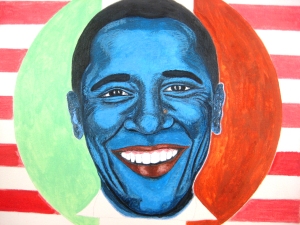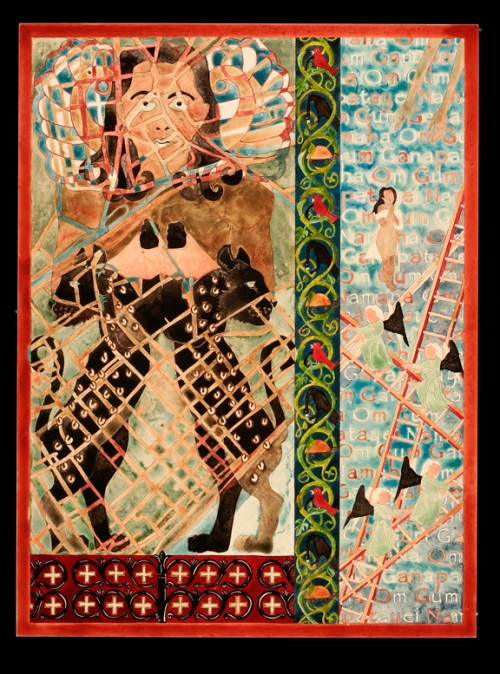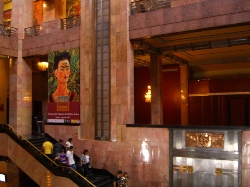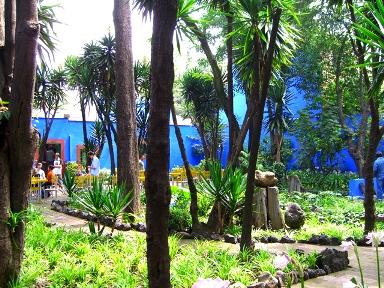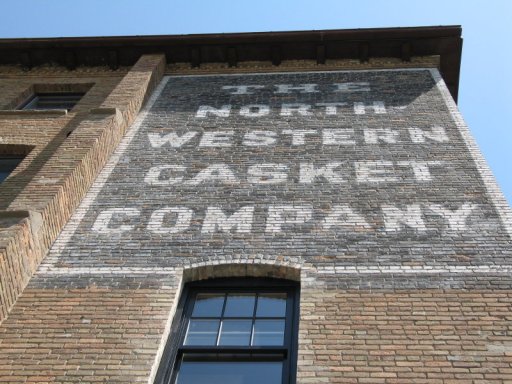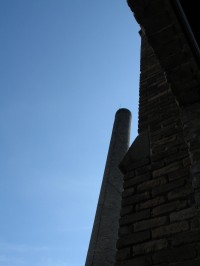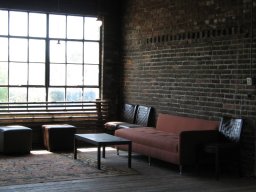
Me, By Pham Luc, portrait of Roma, 26×36 inches, August 2009, image
© 2009 by Pham Luc, photo © 2009 by ybonesy. All rights reserved.
In a small travel agency that sits just around the corner from the Hanoi Cathedral, I wait as the owner, Tony Pham, fills out paperwork for my weekend tour. It is hot, unbearably hot in August in Hanoi, and in spite of the fan, I mop sweat from my neck.
 On the wall behind Tony I see a painting of a red horse against a black background. It’s a small painting but it stands out. The horse wears a cinch around its barrel chest and sloping neck. It is regal, a dancing, prancing stallion.
On the wall behind Tony I see a painting of a red horse against a black background. It’s a small painting but it stands out. The horse wears a cinch around its barrel chest and sloping neck. It is regal, a dancing, prancing stallion.
“Who painted the horse,” I want to know.
Tony looks up from his papers. “Ah, he is a famous painter, mentor to my painting teacher.”
“You paint?” I interrupt.
“No, not really.”
He brushes off my question and points to the artist’s several other paintings hanging in the office. They are bold. Thick black lines contrast with deep, sometimes bright colors. Each piece moves with energy.
Tony tells me he has many more paintings in his home, that he’ll take me to meet the artist.
“Tomorrow afternoon,” he says.
“Tomorrow afternoon,” I repeat, and as I walk through the crowded streets back to my hotel, it dawns on me that Tony is an artist living as a businessman. No wonder his tours are so beautiful and magical.
* * *
Pham Luc’s home is built in the typical Vietnamese style. Narrow and tall, like a shoebox turned on its end. The bottom floor is a one-car garage, then three floors of living space above. It is the first Vietnamese home I’ve been in that hasn’t been converted to a restaurant or shop. I have a feeling it’s a lot nicer than most Vietnamese homes, yet it’s also simple. Some furniture and a lot of art. Besides the bed and sitting area, plus a kitchen and bathroom, the rest of the house, it seems, is dedicated to Pham Luc’s paintings. Making them and storing them.
 Pham Luc is having tea when we arrive. He is a compact man, not so much small as solid, as if he is accustomed to physical labor. His hair is black-black, just a hint of gray at the temples, and he has thick eyebrows and a thick mustache that seem to go together. I have no idea how old he is. Later, when asked to guess, I put him at about 55. I am way off.
Pham Luc is having tea when we arrive. He is a compact man, not so much small as solid, as if he is accustomed to physical labor. His hair is black-black, just a hint of gray at the temples, and he has thick eyebrows and a thick mustache that seem to go together. I have no idea how old he is. Later, when asked to guess, I put him at about 55. I am way off.
A Vietnamese collector of his works is also there, drinking tea with Pham Luc. After introductions, Tony and I walk up the two flights of stairs to rooms filled with paintings. One small room holds nothing but works on framed canvas. Tony flips through them, occasionally pulling out ones he especially admires. A young Vietnamese woman who speaks no English appears at the door. She helps Tony move the paintings around so we can get a better look.
Another room is filled with even bigger pieces, some almost as tall and wide as the walls themselves. These are painted with lacquer on black board. They seem massive and wet, as if dripping still with layers of gold and red and black.
We spend a good amount of time upstairs, looking at the paintings, talking about themes. Pham Luc paints rural scenes, festivals, women and babies, old women, nudes reclining. There is no air-conditioning and by now I am sweating so much that I have used up the tissues I brought with me. Pham Luc’s assistant notices that my face and neck are wet; she leaves and returns with a napkin. Her skin is dry. The Vietnamese, I have concluded, do not sweat.
* * *
I could have spent a century in those rooms, looking from one painting to the next, trying to see how they change. If not for the heat, I could have spent forever trying to guess what his emotional state was when he went from yellows, pinks, and lime greens (elated) to browns and grays and navy blue (depressed).
I gather that he paints his moods, that, yes, he has a fundamental style (in fact, the book he gave me of pieces spanning three decades of his work shows as much) but that nothing about him is static.
 We drink green tea, strong and bitter, and I try to keep up with the men, as if the tea were bourbon. Pham Luc mentions that he does not drink beer, and I get the feeling that it was a decision he was forced to make—beer or art?, art or beer?—at some point in his career.
We drink green tea, strong and bitter, and I try to keep up with the men, as if the tea were bourbon. Pham Luc mentions that he does not drink beer, and I get the feeling that it was a decision he was forced to make—beer or art?, art or beer?—at some point in his career.
But hot tea comes in pot-fulls, brought out by the assistant who doesn’t sweat, always in the same small teapot that looks like it’s made of jade.
Somewhere along the line, Pham Luc tells me he would like to paint me. Tony translates: “He wants to paint you and give you the painting to take home.” A small photo album is produced, and in it I see images of beaming Westerners standing next to their Pham Luc portraits. It is something he sometimes does, I later learn from watching a CD he sends home with me, in order to delight his visitors.
I’m game. (Isn’t it game, after all, that got me here?) I stay where I’m sitting, still dressed in the black blouse and white linen slacks that I wore to my day’s appointments. I look away from Tony and the collector, towards a flat screen TV and more paintings leaning against walls. The assistant comes in with paints and a large canvas stapled to a wooden easel, which Pham Luc props against a chair. He squats in front of the canvas, paints by his side, and he works quietly and quickly.
I don’t look at what he’s doing, partly for the same reason I hate looking at photos of myself and partly to not break the pose. Every now and then I turn to Tony and the collector so that I can ask them questions. They speak in Vietnamese, but Tony translates.
I learn that there is a Pham Luc Collectors Club, that some collectors have thousands of Pham Luc paintings, that his works are owned by ambassadors and dignitaries and people all over the world, and that he has had exhibitions in France, Italy, The Netherlands, Canada. They tell me he will come to Boston in 2010 and, maybe could I go?
If I stay facing Tony and the collector too long, Pham Luc asks me to turn my head back the other way.

My lips are fuller, cheekbones higher. I look French. I look beautiful, and it makes me feel beautiful to know he saw that in me. And for that I immediately love this compact man with the black mustache, and I love Vietnam even more than before, the North especially—erudite, intellectual, lovers of art.
He completed the painting in maybe 30 minutes, although now I can’t be sure. Looking back, time passed and I lost track of time. For example, I have no recollection of him smoking, although I have a photo of his pack of Camel cigarettes, the words SMOKING KILLS in block letters on the front. He must have lit up while I was there, I am sure of it, but I don’t recall being bothered by the smoke.
I do remember that after he finished the portrait and turned the canvas for us to see, we let out a collective gasp. Then Pham Luc walked to us, pointing to his arms and gesturing excitedly. The hair on his forearms stood on end; confused, I looked to Tony for translation.
“It’s good, it’s good,” Tony assured me, “it means the painting is great.”
For the moment, Pham Luc is pure energy.
Later, when I ask Tony in the taxi why Pham Luc would give me a painting, even after I pleaded to purchase it instead, he says it is because of the gift that I gave to Pham Luc. “He knows that now, after his visitors are gone, he will be able to paint.”
Pham Luc paints at night, during daytime, when awake at night, or even if he has just recovered between sicknesses and can sit up. The motivation behind his creation is like a karma, a curse of fate. If he can’t paint he will get sick and will be like a flu-infested chicken. Many times I saw him grubby in a mess of colors and lacquer as if haunted.
~Dr. Nguyen Si Dung, from Painter Fạm Lực
* * *
 It takes an hour, maybe two, for the painting to dry. We continue to sit and talk. At one point I look across to Pham Luc; he is holding a large white envelope close to his face, sketching a doodle of me. When he is done, he shows it to me. Another gift to take home.
It takes an hour, maybe two, for the painting to dry. We continue to sit and talk. At one point I look across to Pham Luc; he is holding a large white envelope close to his face, sketching a doodle of me. When he is done, he shows it to me. Another gift to take home.
Later still, he walks over to a dresser and picks up a small piece of art done in lacquer on wood. I admire it, hand it back, and then Tony translates. “No, it’s for you.”
Then Pham Luc goes and gets two more and asks me to choose from among the three. They are nudes done in simple black lines on gold leaf. I like them all, but Tony and the collector have a strong opinion that I take one in particular, so I choose it.
We talk, drink more tea. Pham Luc gets up and again rummages around the room, notices behind one of the larger paintings a small, colorful portrait of himself on canvas. In the painting, he wears no shirt and holds a cigarette between his fingers. Again, he hands me the painting. A gift.
“Please,” I tell him, “please, it’s too much.”
He says something in Vietnamese, which Tony translates. “You are my friend, and I am his friend, so now you are his friend.”
I glance at the beautiful Roma on the large canvas that is still drying, and I marvel at my luck. Yes, luck! Karma, good fortune, call it whatever you want, but here I am sitting, talking, laughing, drinking tea, being painted, being feted with generosity and brilliance. I am a small thing basking in the light of a huge thing. Someone ordinary touched by someone extraordinary.
I am disabled but crazy about Pham Luc’s paintings. Many Vietnamese and foreign friends coming to my home to see my collection were amazed at the creations of Pham Luc. Many asked me why I collected so many paintings. I replied, “Each painting is a support for me to overcome handicap and integrate into life. His paintings give me confidence in life and aspiration to rise up. In my difficult times and in pain, I come to his paintings to seek consolation, sympathy and often find in them peace amidst the storms of life.”
~Ngo Quang Tuan, from Painter Fạm Lực
* * *
Pham Luc was born in 1943 in the village of Hue. He was a soldier and painter in Vietnam’s People’s Army, documenting the scenes he saw. From the books and brochures I have about him, I understand he became a major in the army, but always he was a painter. He told me that the reason he is not married—he’s been divorced twice—is that his wives did not understand his need to constantly paint.
There is a painting upstairs in one of the rooms, of a woman with a rifle, behind her a water buffalo. The colors are muted but the overall effect is of activism. Pham Luc painted the piece in 1986, and Tony and I found it behind other, more recent works. Before I leave Pham Luc’s home, I ask the assistant to bring it down so that I might look at it again. There are many beautiful paintings here, but always my eyes go back to the woman with the rifle.
I buy the painting from Pham Luc. For a song.
He doesn’t need money. He spends all his money on charities, his children, and buying gold, silver, lacquer and colors. So what does he need? To build his fame? May be, but may be not. In fact, he is already very famous. Many people know him and admire him. Ambassadors in Hanoi buy his paintings and make friends with him. So the answer to his efforts lies in his passion. Because he can’t do otherwise.
~Dr. Nguyen Si Dung, from Painter Fạm Lực
* * *

Sòn d âù, (I hope that spelling is correct), 32×24 inches, 1986, image © 1986-2009
by Pham Luc, photo © 2009 by ybonesy. All rights reserved.
I am deeply grateful to Tony Pham and to Pham Luc. The three hours I spent with the two of them that day in early August are among the best memories I have of Vietnam, of travel abroad, and of life experiences, period. In Tony, I found a kindred spirit, an artist inside his heart, and someone whose love of art infuses his daily work. In Pham Luc, I found kindness, happiness, and what it means to give of oneself.
He was born in a poor countryside in a deprived village in the Central region of Vietnam and used to be a soldier fighting in the wars. He lives and paints with qualities of a farmer and Uncle Ho soldier. These qualities have become his humane belongings. No wonder many people sympathize with, love, and are crazy for his art. He is so happy!
~An Chuong, from Painter Fạm Lực
* * *
GALLERY
These are works that I photographed during my visit. They are my favorites among the many that I saw that day. I do not have names, dates, nor sizes for any of the paintings. They all appear to be oil on canvas, and almost all of them are fairly large. They are reprinted here with the artist’s permission.







LINKS
Read Full Post »


























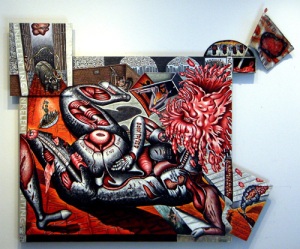


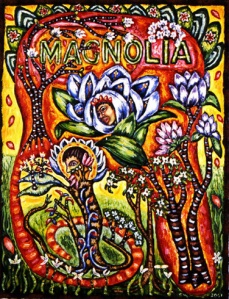




 About herself, Cathy writes: I was born and raised in northwest Indiana. With great excitement I departed to the West Coast for college. First to Immaculate Heart College in Los Angeles for a few years, then I transferred to San Francisco State University for a change and to get my BA. My time in California was transformative, clarifying my personal vision and actifying my presence in the world. This was in the late 70’s.
About herself, Cathy writes: I was born and raised in northwest Indiana. With great excitement I departed to the West Coast for college. First to Immaculate Heart College in Los Angeles for a few years, then I transferred to San Francisco State University for a change and to get my BA. My time in California was transformative, clarifying my personal vision and actifying my presence in the world. This was in the late 70’s.






